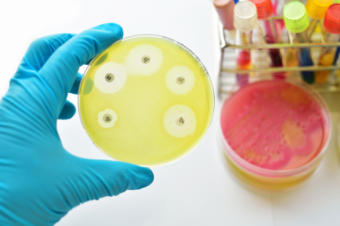New antibiotics needed: Enterobacteriaceae
Posted on November 14, 2018 by Laura Cox
Continuing on our New Antibiotics Needed blog series, today we will be exploring β-lactamase-producing and carbapenemase-producing Enterobacteriaceae.

- Salmonella is a food-borne disease often
- associated with raw or incorrectly prepared chicken
Enterobacteriaceae is a family of bacteria often associated with the gut. Some Enterobacteriaceae may be more familiar than others, including Salmonella, Escherichia coli and Shigella.
Another important bacterium in this family is Klebsiella pneumoniae. When in the lungs, this bacterium causes a particularly aggressive form of pneumonia. Even when treated with antibiotics, fatality of K. pneumoniae lung infections can be as high as 50%.
Resistance to Carbapenems – a group of antibiotics often described as ‘the last line of antibiotic defence’ – is becoming increasingly common in Enterobacteriaceae. This has prompted the World Health Organization (WHO) to rate the need for new antibiotics against Enterobacteriaceae-family bacteria as critically important.
The last line of defence
Carbapenems are broad-spectrum antibiotics that are usually reserved to treat severe bacterial infections that are known to be resistant to other antibiotics. The drugs are usually only administered intravenously (through a drip) in a hospital setting and so their use is relatively well controlled when compared with other broad-spectrum antibiotics.
Carbapenems work in a similar way to penicillin. Like penicillin, these drugs contain a molecular structure called a beta-lactam ring. This ring targets the bacterial cell wall and stops the bacteria from dividing, eventually killing the bacteria and preventing the infection from spreading.
Due to the pressures on bacteria to survive, many have developed the ability to produce an enzyme called beta-lactamase. This enzyme cuts the beta-lactam ring before it can attack the bacteria, making the bacteria resistant to penicillin. In carbapenems, the ring is more stable and cannot be cut by beta-lactamase. However, resistance is emerging, and some bacteria can now produce carbapenemase; an enzyme that can even cleave the more stable ring that gives carbapenems their antibiotic effect.
A threat to Europe

In Europe, Enterobacteriaceae resistant to carbapenems is becoming more prevalent. In Greece, as many as 55% of isolates are carbapenem-resistant, one of the highest rates in the world. Prevalence is worst in countries which have particularly high usage rates like Greece, Italy and Romania. How long their use can be sustained remains to be seen.
To try and stem the rising tide of resistance in Europe, the European Union has banned the use of some antimicrobials in animals. Colistin is an antibiotic frequently used in food production, but in 2006 its use as a growth-promoter was banned in Europe. This was decided after Colistin was found to be an effective last-last line of defence when treatment with carbapenems fails. China decided to follow suit in 2016 after findings showed that resistance to Colistin was spreading to human pathogens.
Extended-spectrum β-lactamase-producing and carbapenemase-producing Enterobacteriaceae is the second review in the New Antibiotics Needed collection in Microbial Genomics. Written by Hayley Wilson and M. Estée Török from the University of Cambridge, the review discusses the different mechanisms of carbapenem resistance, where different forms of resistance are most prevalent, and what the future might look like for the continued use of this antibiotic that is so essential for human health.

